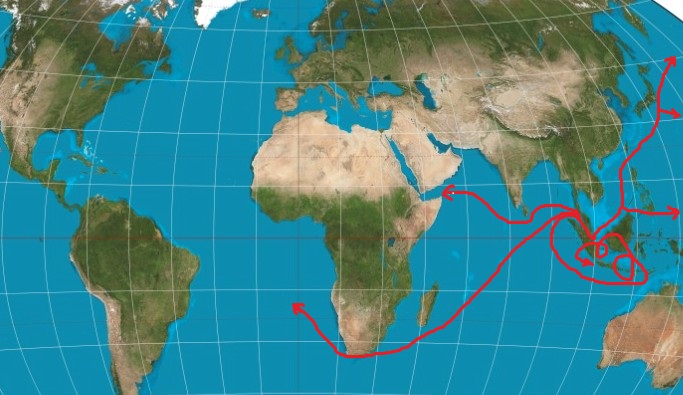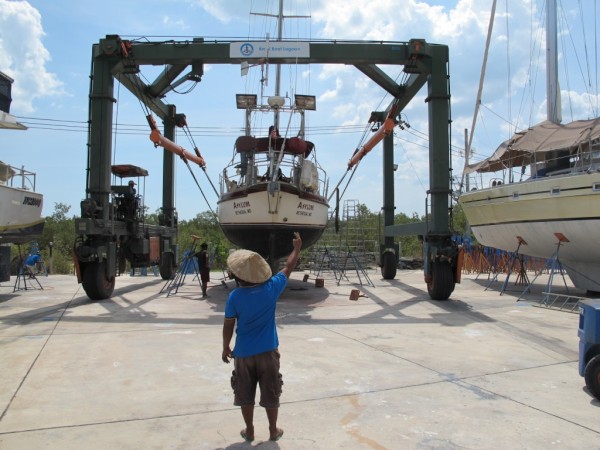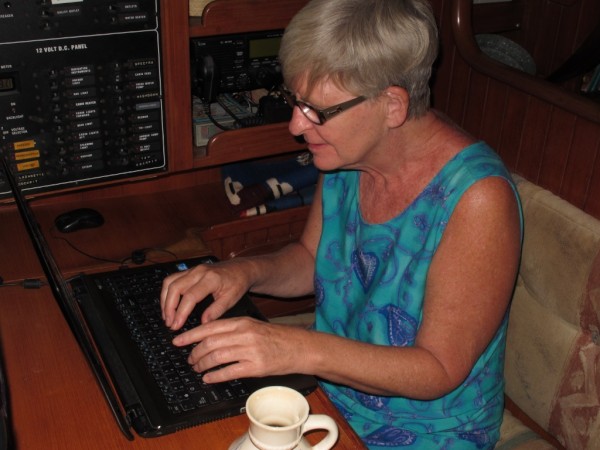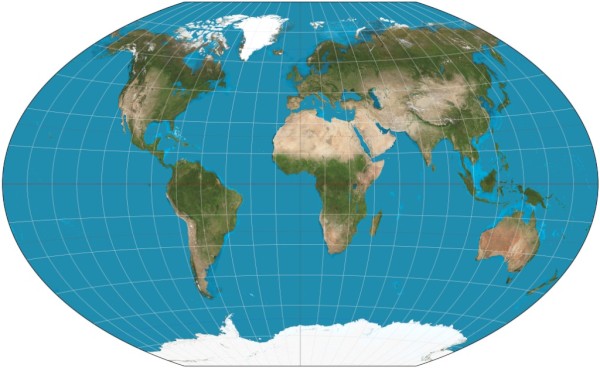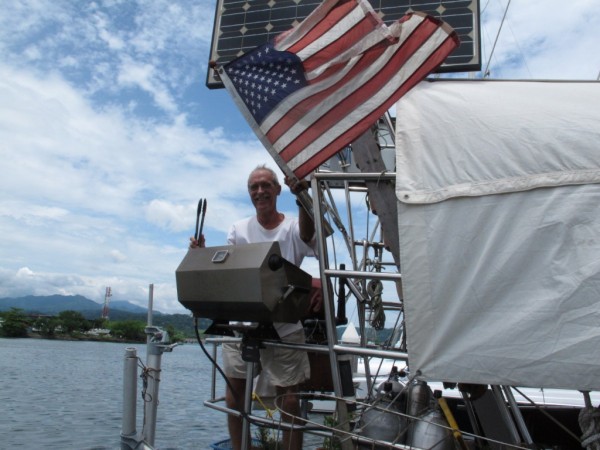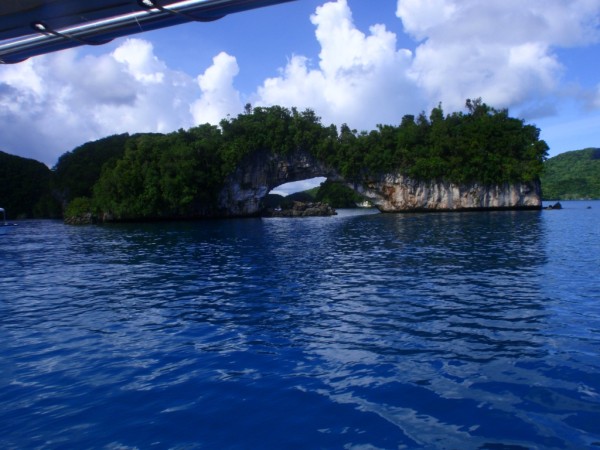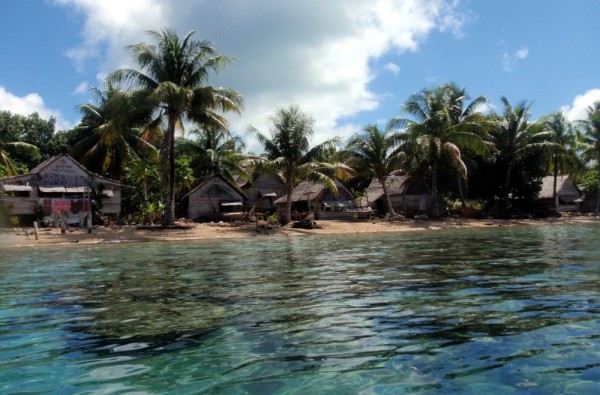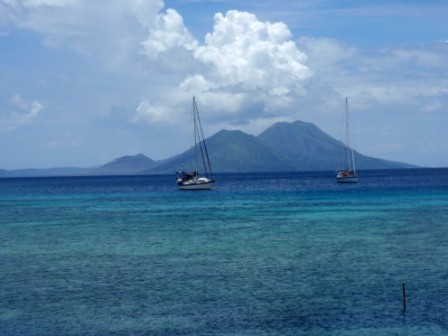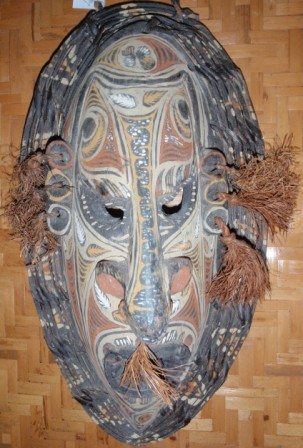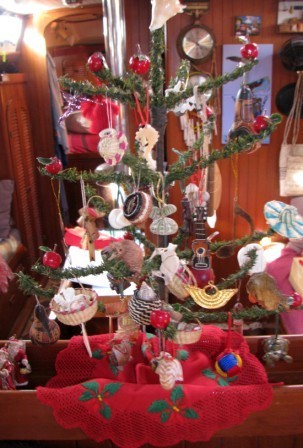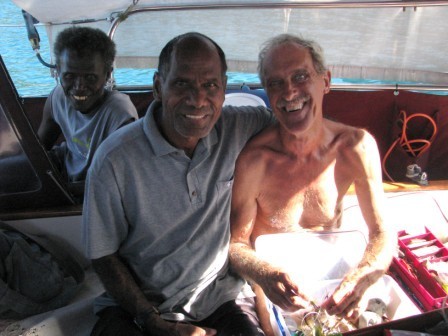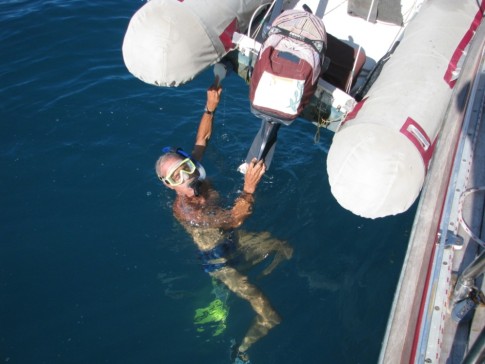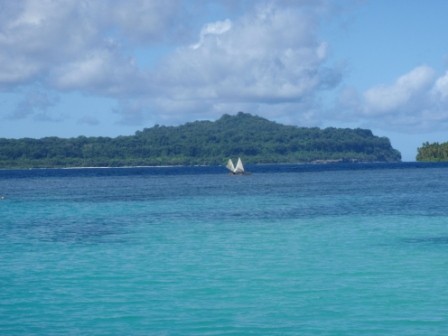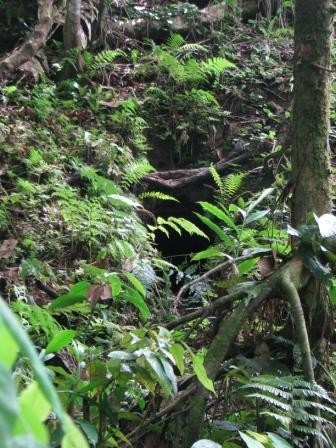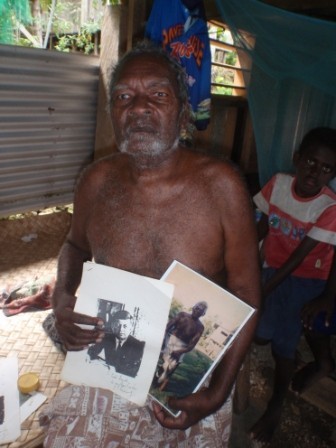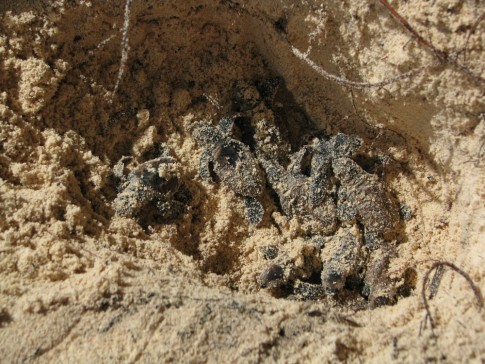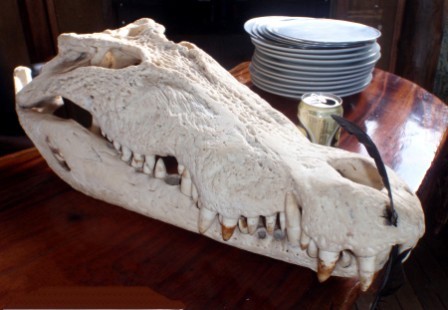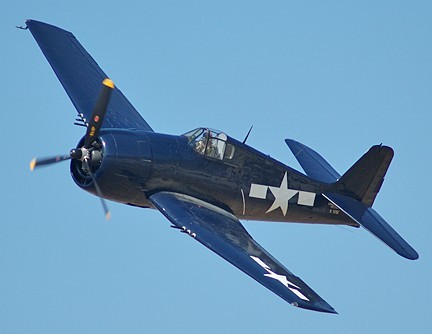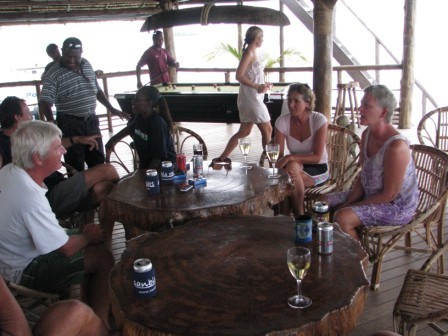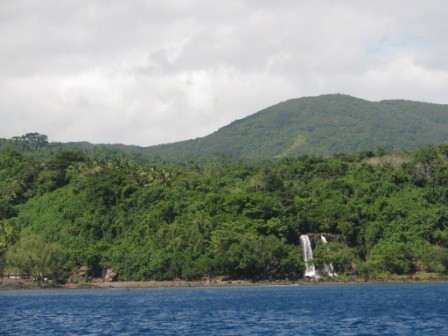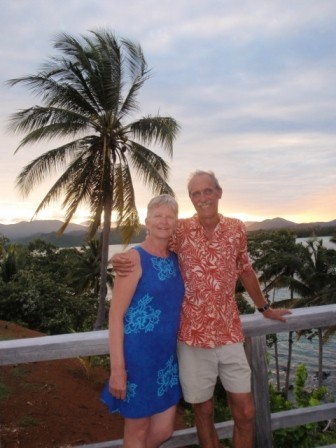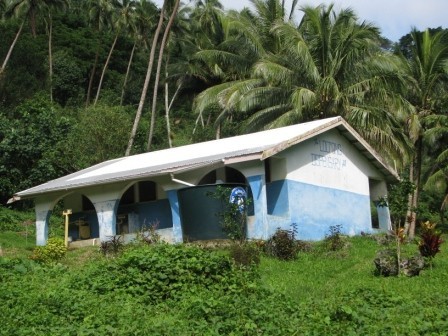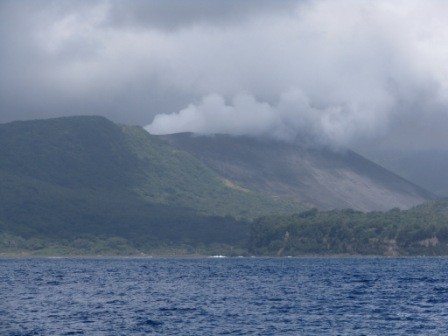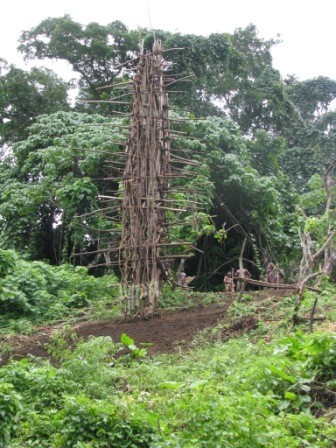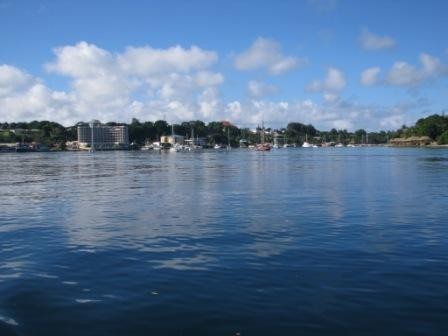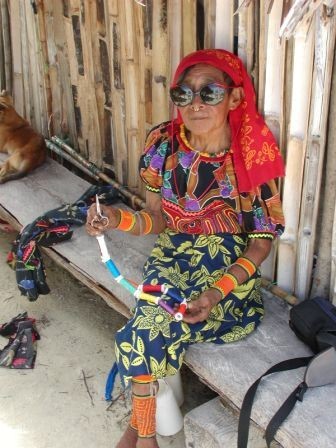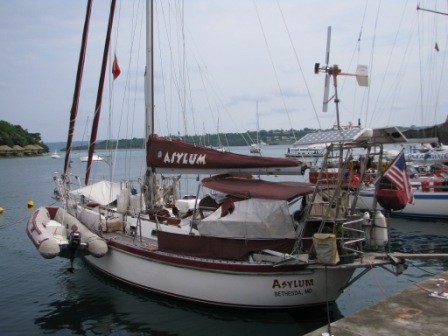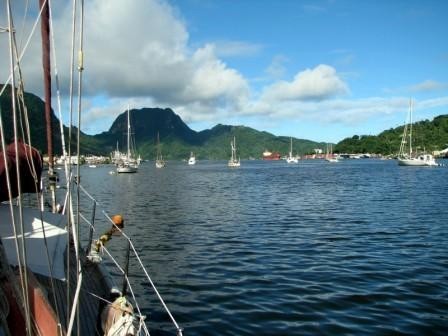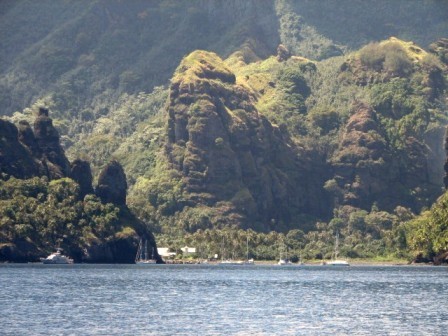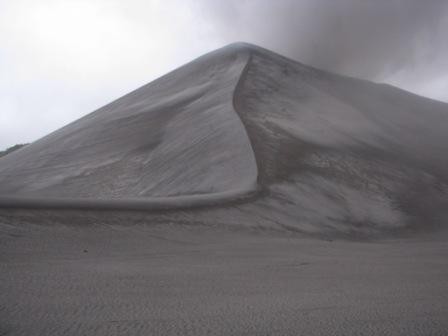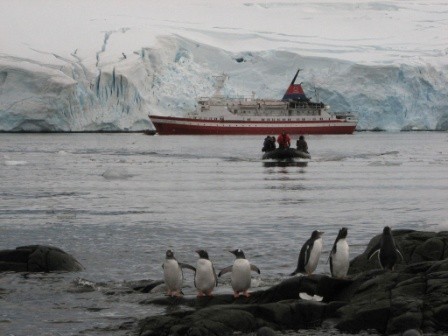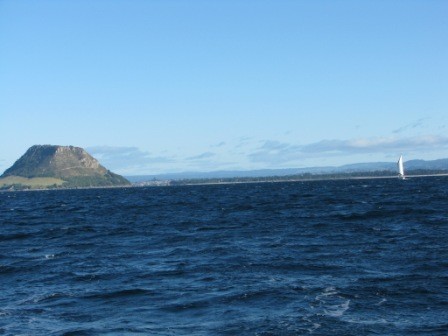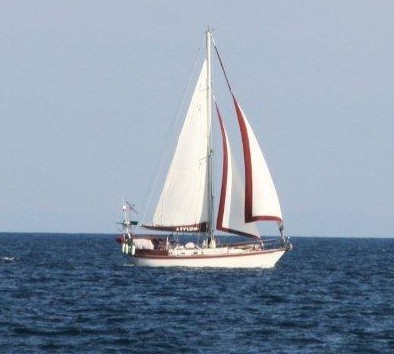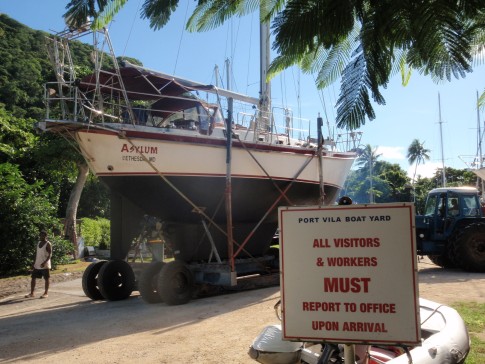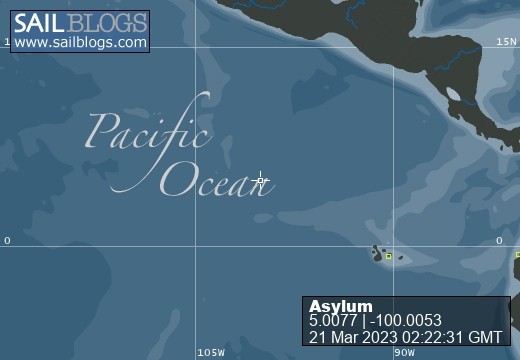
Asylum
22 June 2019 | Straits Quay Marina, Penang, Malaysia
17 July 2016 | Penang, Malaysia
20 February 2016 | Penang, Malaysia
02 October 2015 | Thailand
11 April 2015 | Krabi Boat Lagoon Marina, Thailand
25 December 2014 | Langkawi, Malaysia
04 June 2014 | Philippines
07 January 2014 | Brookeville, MD
04 July 2013 | Subic Bay Yacht Club, Philippines
31 October 2012 | Palau
02 December 2011 | Hermit Islands, Papua New Guinea
08 November 2011 | Maryland, USA
15 May 2011 | Kavieng, New Ireland, PNG
26 April 2011 | Kavieng, New Ireland
26 March 2011 | Kokopo, New Britain, Papua New Guinea
16 March 2011 | Kokopo, New Britain, Papua New Guinea
12 February 2011 | From Peava again
05 February 2011 | Solomon Islands
01 December 2010 | From Lola Island, VonaVona Lagoon, Solomon Islands
30 November 2010 | Peava, Nggatoke, Solomon Islands
Inmate Update #8: Virgin Islands to Venezuela
15 June 2001 | Isla Margarita, Venezuela
It's time to head south. Hurricane Season officially started on June 1 and we have a month of statistical grace to get below 12*40'N before our insurance company declares us uninsured. If we get hit by a "named storm" while "in the box" (a big rectangle that covers most of the Caribbean), all bets are off. If a named storm hits us while we're out of the box (i.e., in the "safe zone"), our deductible merely doubles. Insured or not, we don't want to be anywhere near any named storms! So the fleet all goes south. Last year we were at the southern end of Grenada and then in Trinidad for hurricane season; this year we're bound for Venezuela.
We were shooting to leave the first week of June, ideally around the 5th if the weather was good, because the 5th was the full moon and we would have 2 nights underway from St. Croix to Isla Blanquilla, off the north coast of Venezuela, our planned first stop. (Having a full moon can be a mixed blessing. If the conditions are good, the full moon makes the nights shimmer and greatly aids watching out for other vessels. If, on the other hand, they're not good, and the seas are rough, it's almost better not to be able to see what's being dished up.) Friends on another Tayana (a 52 footer we'd met back in the Chesapeake called Endless Summer) were heading the same way, so the plan was to buddy-boat with them. Glenn and Jim started the weather watch around the 1st to keep an eye on the march of tropical waves that already had started to rumble across the Atlantic from West Africa with relentless regularity. (These are the weather disturbances that can turn into hurricanes when a variety of conditions are just right, and can be pesky in and of themselves sometimes.) They come every 3 to 4 days during "the season," so our goal was to scoot out as soon as one passed and before another arrived. It looked like the weather frogs were offering up just about a perfect forecast for the 5th: easterly winds around 15 knots, seas 2 - 4 feet. No waves in sight. We started to make preparations to boogey:
- Put the dinghy on the foredeck and lash it down. We never tow it on long treks.
- Stow everything that could possibly fly. (We never seem to do this task terribly well. No matter how much we stuff into various lockers, with pillows and towels stuffed on top of the stuff to hold it in place, and no matter how neat and clean the cabin looks when we set out, something always manages to fly. We call it letting things seek their own level. And for the most part, unless they pose a danger to below-decks navigation, we just let them be at the level they've sought.)
- Assemble as much food as possible to minimize galley time when we're heeled over at 20*. This includes digging out passage-making snacks and making a couple of ready-to-eat meals (This time I made a large pasta salad and some not-very-good chili, which created a different kind of wind problem later on... Beans and rice is our standard passage fare cuz it sticks to the bowl, the spoon, and your ribs.)
- Prepare the sea berth. (We were going to try to use the quarter berth this time rather than the main salon, which we usually use, but after one sleep attempt back there, Jim declared it too noisy and we went back to the main salon. Given our port tack and heel angle, the main salon berth was also better for positioning your body not to fall on the floor.)
- Pull out the "but-out bag" and add to its standing contents our wallets, the official boat papers, our passports, a hand-held VHF radio, some add'l food, and a change of clothes.
Just in case you're interested, here's a list of stuff resident in the bug-out bag at all times:
- Fishing kit with rod, reel, tackle
- Playing cards
- Dental kit (1 each small tooth brush, toothpaste, mouthwash)
- Signaling Stuff: Hand Flares, Air horn, Signaling mirror, Parachute Flares, Smoke canister
- Sharpening stone and small folding knife
- EPIRB w/GPS and a small handheld GPS
- First aid kit (one of those pre-packaged things) w/ little medical/first aid book in it & add'l stuff like first aid cream, Cortaid, thermometer, sea sickness pills; aspirin & ibuprofen, Chapstick and "Lip Medex"
- Food/provisions (in addition to stuff like C-rations packed in the life-raft itself): Life savers, gum, soy sauce (for eating raw fish), fruit cups, non-fat dry milk, multi-vitamins, raisins
- Canister of Wet Ones
- Coffee mugs
- Forever Lights (flashlights)
- Steno pad and 2 pens
- Reading glasses and Sunglasses
- 2 "no-brainer" paperback books
- Handheld water maker
- Toilet paper
- Cutting board (for making sashimi!)
- Copies of passports and boat papers
- Cash (about $1100)
- Book: Water Wise, Safety for the Recreational Boater (w/ a survival section)
- "Chamois" cloth
These items were selected from among various lists of recommended contents in cruising books and magazines we've read. Many of those lists suggest much more stuff, but we're banking on our combination EPIRB/GPS to reduce the amount of time we would be bobbing around out there. Frankly, we're planing not to need any of this stuff, but you never know, so we've concocted what we consider to be a prudent list of bug-out needs.
We keep the bug-out-bag at the bottom of the companionway stairs while underway so that it can be easily hoisted into the cockpit should we need it. I say "easily" but I'm not sure how easy it really will be. The damn thing is heavy with all that stuff in it! Supposedly the bag and contents will float, but we don't care to test that...
We calculated our passage time from St. Croix to Blanquilla at about 60 hours. We tend to estimate our travel times conservatively (at an average of 5.5 knots) to figure on worst case arrival times. As I think I mentioned in an earlier update, we always base our departure time on when we want to arrive in the new place, the cardinal rule being never arrive at night. (Most sailors will slow down, heave to, or just stand off a harbor entrance until daylight rather than enter in the dark.) So that meant leaving at about 6 a.m. on Tuesday, the 5th, with projected arrival in Blanquilla on Thursday afternoon. On Monday night we were set to go and went to bed early.
Early Tuesday morning Glenn on Endless Summer downloaded a weather fax that showed a new, as-yet-unreported wave near us. Jim woke me saying "we have a decision to make" (i.e., go or not go). It didn't look like much of a wave, but having been battered once before by one that was mis-forecast, we really didn't want to do it again. We decided to wait for the 0630 Ham-net weather forecast out of Trinidad, and decide then whether to leave, effectively delaying our departure an hour.
The wave was pronounced pretty benign--not much wind activity to it--"so on the dot of 0700 we raised anchor and wended our way around the reefs on St. Croix's north coast to round its east end (the eastern most point of the USA) and turn south. The weather was, in fact, quite gorgeous. Brilliant blue sky, wind (so far) as predicted, seas a little choppier than we expected but not too bad. We put up full sail and pointed the boat south. We sailed a little closer to the wind than the GPS bearing indicated (our course to Blanquilla was 194) in order to make some "easting" should we need to fall off later. Basically what that means is that we took advantage of the good wind and sea conditions to go a little farther east than we needed to (the hard way to go down here) so that if the weather piped up we could sail on a more comfortable angle (i.e., less "on the wind"). Some sailors refer to this as "putting easting in the bank" so you can use it later.
One of our goals for this passage was to get more experience using our wind vane. The wind vane is the mechanical self-steering device mounted on the stern that keeps a course relative to the wind, as opposed to the autopilot, which steers to a compass course. If the winds are steady out of the same direction, you set your sails and the wind vane and go; if there's no wind or fluky wind, you use the autopilot. Most long-distance sailors say that self-steering is the single-most important piece of equipment on their boat. For us, they're essentially additional crew members who don't need to eat, pee, or sleep, and free us from often-strenuous hand steering. We call the autopilot McMurphy and the wind-vane Nurse Ratchet (after the characters in the movie "One Flew Over the Cuckoo's Nest").
Ratchet was doing pretty well, in those first hours, tho she had a slight tendency to want to point up into the wind (which would take us off course). We fiddled and futzed with her for a while and then decided the boat wasn't well-enough balanced (too much weather helm), and put a reef in the main sail. The wind also had picked up, so the reef was probably prudent. That seemed to help Ratchet, and as I wrote in the log, we were "still making good SOG [speed over ground] of 7 knots! An occasional crash into a wave, but mostly she's riding the swells quite nicely. Once in the 'groove,' the ride is pretty smooth."
As the afternoon wore on, the winds picked up--first to 18-20, then consistently over 20, and by about 8 PM they were consistently 25+ knots (we saw an occasional 28), and stayed that way for the rest of the night. We pulled in some of the jib and put a second reef in the main. We were also taking a LOT of spray; the cockpit and everything in it was soaked, and it was too wet to be up there comfortably. While in St. Thomas a few weeks ago, we had a fortuitous conversation with our very experienced cruiser friends on Imaginess, who are on their way across the Atlantic to the Azores, even as I type. They said they didn't spend much time in their cockpit (which is where we hang out most of the time on Asylum), because it isn't very comfortable, and never did watches up there! We were pretty surprised by that, because on all of our passages to date, one of us has always been in the cockpit during the night watches--"sometimes more comfortably than others. Hmmm... we thought. Maybe there's something to this. We have radar below, GPS to monitor our course and speed, and all the other instruments' readings at the nav station. So we adopted the Imaginess System of Watch-keeping: stay below and poke your head out now and then to make sure you're not going to run into anything. Of course, the one time that I did go up to the wheel to check something was one of those moments where a wave hits the boat with a most distinctive thud and showers the cockpit with spray. I was soaked. But the full moon was beautiful and bright, showcasing in all their glory the hefty seas we were plowing thru.
Neither of us usually sleeps very well on the first night out, and Jim was true to form. Since he couldn't sleep, we had a looser watch schedule than usual (we generally do 3 hours on, 3 off), and I benefited from his restlessness by getting more sleep time. The wind stayed up around 25+ all night, and we averaged about 6.5 knots--pretty darn good for a heavy girl like Asylum.
The second day out was mostly overcast and still pretty windy. We think it was the vestiges of whatever that wave had to offer. And definitely too wet to be in the cockpit. At one point, when we were heeled over at about 20o, kinda tired, each of us with a fresh bruise or two, moving gingerly thru the cabin to stay somewhat upright, and things starting to look a little messy below, we said to each other, "do we really want to do this for 3 weeks!?" (the average time it takes to get from the Galapagos Islands to first land-fall in the south Pacific). We reminded ourselves, however, that day 2 of a passage was the worst, and that the trans-Pacific trip is very different sailing from what we were currently experiencing... It seemed to work; we're not yet ready to scrap the plan. Many experienced cruisers we've talked to, people who have done circumnavigations, say that the Caribbean presents some of the toughest sailing conditions in the world. We buy it. We've also heard the Pacific lives up to its name. We're prepared to believe that, too.
The wind stayed pretty high all day, and we were doing better than 7.5 knots for quite a while with considerably reefed sails. Right about the time Jim went down for an evening sleep stretch, I checked the radar to see if there was anything at the 12-mile range. A black splotch to the southeast. Couldn't tell at that point whether it was a ship or rain, but I kept an eye on it. Pretty soon the black dots multiplied and grew; they were clearly rain cells--a bunch of them, some pretty big, all south of us and all moving right across our path. Too many to try to dodge. Jim's famous line whenever we used to see weather on the Chesapeake (and he uses it a lot here too) is, "It'll pass to the north." In this case, I kept saying, "pass to the south, pass to the south." And fortunately they all did. We may have gotten a few sprinkles, but who woulda known, given all the spray we were still taking.
Later, at about 3:30 in the morning, Jim was just starting to stir from a nap. I was sitting at the nav station (probably playing solitaire on the computer), when we both felt and heard the telltale thud of a wave against the hull and next thing we knew, bucketloads of water were pouring down the companionway into the galley. @#*&% saltwater! In the boat. Jim had the presence of mind to push the hatch forward, but it was too late. The water was sloshing all over the galley floor where (fortunately) most of it landed, but the counters and cupboard doors were also well-doused, since we were heeled at about 20 degrees, putting the counter pretty much below the hatchway. I dislike saltwater intensely, and am fastidious to the point of being fanatic about keeping it out of the cabin. This mess did not sit well with me! Needless to say, we spent the next little while getting the worst of the slop mopped up, with more intense cleaning facing us on arrival.
It wasn't long after the saltwater caper that the sun came up, and this time it was a gorgeous day. The seas had laid down somewhat, so it wasn't quite as wet and sloppy above. It was also calm enough to troll a line (which yielded nothing, despite the supposedly fish-rich water we were in...). The bad news was that an adverse current had set in, slowing us down a little, but it was so nice out there that we didn't mind. Our destination island, Blanquilla, is small and flat, so we didn't see it until we were pretty close. Our buddy boat, Endless Summer, being 10' longer than Asylum, is also much faster, so they arrived and were well anchored several hours before we were. They had also visited the local fisherman and procured a bunch of fresh fish, and when we were about 10 miles out, they called us on the radio and invited us for dinner. Landfall is always sweet, but this made it even sweeter! We had the hook down at 3:45 PM on Thursday, 56 hours and 45 minutes after leaving St. Croix. We averaged 6.5 knots, which is really good for this boat. Despite some yucky moments, it was a good trip, and, as always we learned more about both Asylum and us.
We anchored off a gorgeous, deserted beach on the west coast of Blanquilla. Except for 2 other sailboats and some local fisherman, there was nothing there. And except for a brief walk on the beach when we swam to shore from the boat, our feet didn't touch solid ground for over a week. We (reluctantly) left Blanquilla on the 11th to head for Margarita, a more substantial offshore island where we would officially check in to Venezuela. That one-day hop, which we expected to be over by about 3 PM, turned into a race with the setting sun as we had to bypass our intended anchorage and keep going around to the south coast of the island. The spot we were going to anchor was terribly exposed, with gusts of 30 knots and terrible chop. Peddling as fast we could in 25-30 knot winds on the nose, we hurried to get to the next possible anchorage. We came very close to violating the "no entry in the dark" rule, even bumping the very shallow bottom a la our beloved Chesapeake Bay a couple of times on the way into the well-protected mangrove bay. Endless Summer, once again, was already there and put their mast strobe light on, so with the help of a local fisherman who came out from shore to point us in the right direction, and their flashing light, we finally had the hook down as the last trace of light disappeared at 7 PM. Whew.
It was a beautiful spot, really reminding us of anchorages in the Chesapeake Bay. In the morning there were great big, long-legged white birds deliberately picking their way along the shallow shoreline striking at whatever morsels were hiding in the mud. They shared the shallow water with several people wading in the water, some of them neck deep, also harvesting the mud's edible treasures. We stayed there 2 nights, and then moved to Porlamar, the main harbor in Margarita where we would officially check in. By the time all the paperwork was accomplished (via an agent), we had been "yellow flagging it" for over a week. But nobody seemed to care.
We'll write more about Venezuela in a future update. For now, we have quickly learned that security issues are a whole new ballgame here. We have locked down everything we keep on deck (e.g., a dive tank, extra fuel tanks), and rather than just locking the dinghy with a heavy cable to the side of the boat at night, we raise it from the water with a halyard so that it's suspended above deck level. Upon arrival in Margarita the other day, we learned from friends who were already here that their dinghy, which had been cabled with heavy wire to the boat, was stolen a couple of weeks ago, and just last night another cruiser's dinghy was stolen. So we take precautions. But from what we've seen so far, and from what everyone says, this is great cruising territory.
We'll let you know more later. Stay tuned...
The Inmates
We were shooting to leave the first week of June, ideally around the 5th if the weather was good, because the 5th was the full moon and we would have 2 nights underway from St. Croix to Isla Blanquilla, off the north coast of Venezuela, our planned first stop. (Having a full moon can be a mixed blessing. If the conditions are good, the full moon makes the nights shimmer and greatly aids watching out for other vessels. If, on the other hand, they're not good, and the seas are rough, it's almost better not to be able to see what's being dished up.) Friends on another Tayana (a 52 footer we'd met back in the Chesapeake called Endless Summer) were heading the same way, so the plan was to buddy-boat with them. Glenn and Jim started the weather watch around the 1st to keep an eye on the march of tropical waves that already had started to rumble across the Atlantic from West Africa with relentless regularity. (These are the weather disturbances that can turn into hurricanes when a variety of conditions are just right, and can be pesky in and of themselves sometimes.) They come every 3 to 4 days during "the season," so our goal was to scoot out as soon as one passed and before another arrived. It looked like the weather frogs were offering up just about a perfect forecast for the 5th: easterly winds around 15 knots, seas 2 - 4 feet. No waves in sight. We started to make preparations to boogey:
- Put the dinghy on the foredeck and lash it down. We never tow it on long treks.
- Stow everything that could possibly fly. (We never seem to do this task terribly well. No matter how much we stuff into various lockers, with pillows and towels stuffed on top of the stuff to hold it in place, and no matter how neat and clean the cabin looks when we set out, something always manages to fly. We call it letting things seek their own level. And for the most part, unless they pose a danger to below-decks navigation, we just let them be at the level they've sought.)
- Assemble as much food as possible to minimize galley time when we're heeled over at 20*. This includes digging out passage-making snacks and making a couple of ready-to-eat meals (This time I made a large pasta salad and some not-very-good chili, which created a different kind of wind problem later on... Beans and rice is our standard passage fare cuz it sticks to the bowl, the spoon, and your ribs.)
- Prepare the sea berth. (We were going to try to use the quarter berth this time rather than the main salon, which we usually use, but after one sleep attempt back there, Jim declared it too noisy and we went back to the main salon. Given our port tack and heel angle, the main salon berth was also better for positioning your body not to fall on the floor.)
- Pull out the "but-out bag" and add to its standing contents our wallets, the official boat papers, our passports, a hand-held VHF radio, some add'l food, and a change of clothes.
Just in case you're interested, here's a list of stuff resident in the bug-out bag at all times:
- Fishing kit with rod, reel, tackle
- Playing cards
- Dental kit (1 each small tooth brush, toothpaste, mouthwash)
- Signaling Stuff: Hand Flares, Air horn, Signaling mirror, Parachute Flares, Smoke canister
- Sharpening stone and small folding knife
- EPIRB w/GPS and a small handheld GPS
- First aid kit (one of those pre-packaged things) w/ little medical/first aid book in it & add'l stuff like first aid cream, Cortaid, thermometer, sea sickness pills; aspirin & ibuprofen, Chapstick and "Lip Medex"
- Food/provisions (in addition to stuff like C-rations packed in the life-raft itself): Life savers, gum, soy sauce (for eating raw fish), fruit cups, non-fat dry milk, multi-vitamins, raisins
- Canister of Wet Ones
- Coffee mugs
- Forever Lights (flashlights)
- Steno pad and 2 pens
- Reading glasses and Sunglasses
- 2 "no-brainer" paperback books
- Handheld water maker
- Toilet paper
- Cutting board (for making sashimi!)
- Copies of passports and boat papers
- Cash (about $1100)
- Book: Water Wise, Safety for the Recreational Boater (w/ a survival section)
- "Chamois" cloth
These items were selected from among various lists of recommended contents in cruising books and magazines we've read. Many of those lists suggest much more stuff, but we're banking on our combination EPIRB/GPS to reduce the amount of time we would be bobbing around out there. Frankly, we're planing not to need any of this stuff, but you never know, so we've concocted what we consider to be a prudent list of bug-out needs.
We keep the bug-out-bag at the bottom of the companionway stairs while underway so that it can be easily hoisted into the cockpit should we need it. I say "easily" but I'm not sure how easy it really will be. The damn thing is heavy with all that stuff in it! Supposedly the bag and contents will float, but we don't care to test that...
We calculated our passage time from St. Croix to Blanquilla at about 60 hours. We tend to estimate our travel times conservatively (at an average of 5.5 knots) to figure on worst case arrival times. As I think I mentioned in an earlier update, we always base our departure time on when we want to arrive in the new place, the cardinal rule being never arrive at night. (Most sailors will slow down, heave to, or just stand off a harbor entrance until daylight rather than enter in the dark.) So that meant leaving at about 6 a.m. on Tuesday, the 5th, with projected arrival in Blanquilla on Thursday afternoon. On Monday night we were set to go and went to bed early.
Early Tuesday morning Glenn on Endless Summer downloaded a weather fax that showed a new, as-yet-unreported wave near us. Jim woke me saying "we have a decision to make" (i.e., go or not go). It didn't look like much of a wave, but having been battered once before by one that was mis-forecast, we really didn't want to do it again. We decided to wait for the 0630 Ham-net weather forecast out of Trinidad, and decide then whether to leave, effectively delaying our departure an hour.
The wave was pronounced pretty benign--not much wind activity to it--"so on the dot of 0700 we raised anchor and wended our way around the reefs on St. Croix's north coast to round its east end (the eastern most point of the USA) and turn south. The weather was, in fact, quite gorgeous. Brilliant blue sky, wind (so far) as predicted, seas a little choppier than we expected but not too bad. We put up full sail and pointed the boat south. We sailed a little closer to the wind than the GPS bearing indicated (our course to Blanquilla was 194) in order to make some "easting" should we need to fall off later. Basically what that means is that we took advantage of the good wind and sea conditions to go a little farther east than we needed to (the hard way to go down here) so that if the weather piped up we could sail on a more comfortable angle (i.e., less "on the wind"). Some sailors refer to this as "putting easting in the bank" so you can use it later.
One of our goals for this passage was to get more experience using our wind vane. The wind vane is the mechanical self-steering device mounted on the stern that keeps a course relative to the wind, as opposed to the autopilot, which steers to a compass course. If the winds are steady out of the same direction, you set your sails and the wind vane and go; if there's no wind or fluky wind, you use the autopilot. Most long-distance sailors say that self-steering is the single-most important piece of equipment on their boat. For us, they're essentially additional crew members who don't need to eat, pee, or sleep, and free us from often-strenuous hand steering. We call the autopilot McMurphy and the wind-vane Nurse Ratchet (after the characters in the movie "One Flew Over the Cuckoo's Nest").
Ratchet was doing pretty well, in those first hours, tho she had a slight tendency to want to point up into the wind (which would take us off course). We fiddled and futzed with her for a while and then decided the boat wasn't well-enough balanced (too much weather helm), and put a reef in the main sail. The wind also had picked up, so the reef was probably prudent. That seemed to help Ratchet, and as I wrote in the log, we were "still making good SOG [speed over ground] of 7 knots! An occasional crash into a wave, but mostly she's riding the swells quite nicely. Once in the 'groove,' the ride is pretty smooth."
As the afternoon wore on, the winds picked up--first to 18-20, then consistently over 20, and by about 8 PM they were consistently 25+ knots (we saw an occasional 28), and stayed that way for the rest of the night. We pulled in some of the jib and put a second reef in the main. We were also taking a LOT of spray; the cockpit and everything in it was soaked, and it was too wet to be up there comfortably. While in St. Thomas a few weeks ago, we had a fortuitous conversation with our very experienced cruiser friends on Imaginess, who are on their way across the Atlantic to the Azores, even as I type. They said they didn't spend much time in their cockpit (which is where we hang out most of the time on Asylum), because it isn't very comfortable, and never did watches up there! We were pretty surprised by that, because on all of our passages to date, one of us has always been in the cockpit during the night watches--"sometimes more comfortably than others. Hmmm... we thought. Maybe there's something to this. We have radar below, GPS to monitor our course and speed, and all the other instruments' readings at the nav station. So we adopted the Imaginess System of Watch-keeping: stay below and poke your head out now and then to make sure you're not going to run into anything. Of course, the one time that I did go up to the wheel to check something was one of those moments where a wave hits the boat with a most distinctive thud and showers the cockpit with spray. I was soaked. But the full moon was beautiful and bright, showcasing in all their glory the hefty seas we were plowing thru.
Neither of us usually sleeps very well on the first night out, and Jim was true to form. Since he couldn't sleep, we had a looser watch schedule than usual (we generally do 3 hours on, 3 off), and I benefited from his restlessness by getting more sleep time. The wind stayed up around 25+ all night, and we averaged about 6.5 knots--pretty darn good for a heavy girl like Asylum.
The second day out was mostly overcast and still pretty windy. We think it was the vestiges of whatever that wave had to offer. And definitely too wet to be in the cockpit. At one point, when we were heeled over at about 20o, kinda tired, each of us with a fresh bruise or two, moving gingerly thru the cabin to stay somewhat upright, and things starting to look a little messy below, we said to each other, "do we really want to do this for 3 weeks!?" (the average time it takes to get from the Galapagos Islands to first land-fall in the south Pacific). We reminded ourselves, however, that day 2 of a passage was the worst, and that the trans-Pacific trip is very different sailing from what we were currently experiencing... It seemed to work; we're not yet ready to scrap the plan. Many experienced cruisers we've talked to, people who have done circumnavigations, say that the Caribbean presents some of the toughest sailing conditions in the world. We buy it. We've also heard the Pacific lives up to its name. We're prepared to believe that, too.
The wind stayed pretty high all day, and we were doing better than 7.5 knots for quite a while with considerably reefed sails. Right about the time Jim went down for an evening sleep stretch, I checked the radar to see if there was anything at the 12-mile range. A black splotch to the southeast. Couldn't tell at that point whether it was a ship or rain, but I kept an eye on it. Pretty soon the black dots multiplied and grew; they were clearly rain cells--a bunch of them, some pretty big, all south of us and all moving right across our path. Too many to try to dodge. Jim's famous line whenever we used to see weather on the Chesapeake (and he uses it a lot here too) is, "It'll pass to the north." In this case, I kept saying, "pass to the south, pass to the south." And fortunately they all did. We may have gotten a few sprinkles, but who woulda known, given all the spray we were still taking.
Later, at about 3:30 in the morning, Jim was just starting to stir from a nap. I was sitting at the nav station (probably playing solitaire on the computer), when we both felt and heard the telltale thud of a wave against the hull and next thing we knew, bucketloads of water were pouring down the companionway into the galley. @#*&% saltwater! In the boat. Jim had the presence of mind to push the hatch forward, but it was too late. The water was sloshing all over the galley floor where (fortunately) most of it landed, but the counters and cupboard doors were also well-doused, since we were heeled at about 20 degrees, putting the counter pretty much below the hatchway. I dislike saltwater intensely, and am fastidious to the point of being fanatic about keeping it out of the cabin. This mess did not sit well with me! Needless to say, we spent the next little while getting the worst of the slop mopped up, with more intense cleaning facing us on arrival.
It wasn't long after the saltwater caper that the sun came up, and this time it was a gorgeous day. The seas had laid down somewhat, so it wasn't quite as wet and sloppy above. It was also calm enough to troll a line (which yielded nothing, despite the supposedly fish-rich water we were in...). The bad news was that an adverse current had set in, slowing us down a little, but it was so nice out there that we didn't mind. Our destination island, Blanquilla, is small and flat, so we didn't see it until we were pretty close. Our buddy boat, Endless Summer, being 10' longer than Asylum, is also much faster, so they arrived and were well anchored several hours before we were. They had also visited the local fisherman and procured a bunch of fresh fish, and when we were about 10 miles out, they called us on the radio and invited us for dinner. Landfall is always sweet, but this made it even sweeter! We had the hook down at 3:45 PM on Thursday, 56 hours and 45 minutes after leaving St. Croix. We averaged 6.5 knots, which is really good for this boat. Despite some yucky moments, it was a good trip, and, as always we learned more about both Asylum and us.
We anchored off a gorgeous, deserted beach on the west coast of Blanquilla. Except for 2 other sailboats and some local fisherman, there was nothing there. And except for a brief walk on the beach when we swam to shore from the boat, our feet didn't touch solid ground for over a week. We (reluctantly) left Blanquilla on the 11th to head for Margarita, a more substantial offshore island where we would officially check in to Venezuela. That one-day hop, which we expected to be over by about 3 PM, turned into a race with the setting sun as we had to bypass our intended anchorage and keep going around to the south coast of the island. The spot we were going to anchor was terribly exposed, with gusts of 30 knots and terrible chop. Peddling as fast we could in 25-30 knot winds on the nose, we hurried to get to the next possible anchorage. We came very close to violating the "no entry in the dark" rule, even bumping the very shallow bottom a la our beloved Chesapeake Bay a couple of times on the way into the well-protected mangrove bay. Endless Summer, once again, was already there and put their mast strobe light on, so with the help of a local fisherman who came out from shore to point us in the right direction, and their flashing light, we finally had the hook down as the last trace of light disappeared at 7 PM. Whew.
It was a beautiful spot, really reminding us of anchorages in the Chesapeake Bay. In the morning there were great big, long-legged white birds deliberately picking their way along the shallow shoreline striking at whatever morsels were hiding in the mud. They shared the shallow water with several people wading in the water, some of them neck deep, also harvesting the mud's edible treasures. We stayed there 2 nights, and then moved to Porlamar, the main harbor in Margarita where we would officially check in. By the time all the paperwork was accomplished (via an agent), we had been "yellow flagging it" for over a week. But nobody seemed to care.
We'll write more about Venezuela in a future update. For now, we have quickly learned that security issues are a whole new ballgame here. We have locked down everything we keep on deck (e.g., a dive tank, extra fuel tanks), and rather than just locking the dinghy with a heavy cable to the side of the boat at night, we raise it from the water with a halyard so that it's suspended above deck level. Upon arrival in Margarita the other day, we learned from friends who were already here that their dinghy, which had been cabled with heavy wire to the boat, was stolen a couple of weeks ago, and just last night another cruiser's dinghy was stolen. So we take precautions. But from what we've seen so far, and from what everyone says, this is great cruising territory.
We'll let you know more later. Stay tuned...
The Inmates
Comments
| Vessel Name: | Asylum |
| Vessel Make/Model: | Tayana V-42 Cutter |
| Hailing Port: | Bethesda, MD USA |
| Crew: | Jim & Katie Coolbaugh |
| About: | |
| Extra: | Within Malaysia: 0174209362 (Maxis) WhatsApp +60174209362 |
The Meanderings of Asylum and the Inmates
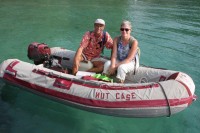
Who: Jim & Katie Coolbaugh
Port: Bethesda, MD USA
Where in the world is Asylum?
Good links
- Vesper Marine Watchmate AIS
- WinchRite Cordless Winch Handle
- Diving at Tubbataha Reef
- Royal Belau Yacht Club, Palau
- ShipTrack: Our route so far
- Passage Weather
- Interview With a Cruiser Project
- Great diving in the Solomons
- Seven Seas Cruising Association
- Divers Alert Network
- Spectra Watermakers
- Rocna Anchors
.jpeg)
